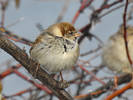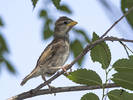search
classification
|
basic information
|
video
|
reports |
Spanish Sparrow
Passer hispaniolensis (Temminck, 1820)

|
 spring male
|
|
|
2019-05-11
Ozyornoe Chuyskaya dolina |
© Irina Romanovskaia
|
|
Description
On the male of the Spanish Sparrow the mantle and shoulders are black contrast bordered on the plain dark-chestnut crown and neck. The buffy-grey edges of the mantle feathers are easy expressed. The uppertail is olive-grey. The cheeks, ear coverts, flanks of the neck, strip behind the ear, and supercilium are white. The lore, under eye strip, chin, throat and craw are black. The flanks with large black strips. The middle of the breast, abdomen and undertail are white. The lesser wing coverts are brownish, the median ones are brownish-black with the white tips formed the white wing bar. The greater wing coverts are with the broad yellowish-brownish edges. The axillaries and underwing coverts are white; the flight and tail feathers are dark-brown. The secondaries with dark-brown edges, the primaries with lighter ones. The bill is black, the legs are dark-brown. The spring female has olive-grey upperparts. Dark-brownish central parts of the feathers on the head and sometimes on the neck form the dusky slightly visible mottle pattern; on the mantle they are larger and form two pairs of longitudinal strips, between which the two pale or yellowish-white strips belong. The supercilium is pale. The cheeks, ear coverts, flanks of the neck and all underparts are buffy-greyish. Much of females have on the throat, craw and flanks the faint male's pattern; formed by dark-brownish feathers with the broad light edges. The flight and tail feathers are brownish. The bill is dark-brown; the legs are brownish. In fresh plumage the adult birds have the broad buffy edges, which almost hide the plumage pattern. Juveniles are similar on female but lighter and more buffy. The bill is yellowish-brownish, legs are brownish. Weight 22,2-37,5 grams, wing 72-83, tail 45-60 mm.
Biology
Spanish Sparrow is common breeding migrant in Kazakhstan. It inhabits the shrub thickets, forest-belts, gardens and groves close to the water and often nearby the cereal fields (barley especially). In foothills it lives near humans settlements on 1370-1900 m. At non-breeding time it visits the stubble fields, reed-beds, gardens, grape plantations, riparian forest and thickets of tall weeds. It appears late, in mid April – early May by the small groups and by the large flocks sometimes up to 2-3 thousand birds, mostly with Indian Sparrow together. The intense migration occurs in May. The Spanish Sparrow breeds in huge colonies numbering up to 800 thousand pairs. The density of nesting is 5500-36000, on the average near 13000, nests per hectare. May be more than one hundred nests of Spanish Sparrow are built on a one tree. Rare nests in group less than one hundred pairs. Birds form the colony very rapidly during several days. Males begin to build the sphere-shaped nests and loudly invite the attention of females. Builds nest on tree (Bolle's Poplar, Elm, Russian Olive, Ash-leafed Maple, Willow, Apple, Pear, Apricot, Bastard Acacia) or in bush (tamarisk, Halimodendron halodendron) on 1-15 m above ground high. On contradiction from other sparrows species the Spanish Sparrow builds nest from various green grasses (gladly uses fresh cut lucerne) and doesn't inlay the nest by feathers and downs. Nest is lined by the green wormwood and leaves. Male builds nest during 2-7 days. Female helps on late stage of construction. Clutches of 2-7 (usually 4-5) eggs are laid in mid-May – mid-July, female incubates for 12-14 days, sometimes male helps it. Both parents feed juveniles, which fledge at 11-12 days old, in mid-June – mid-August. Some pairs rear two broods, though belated breeders can rear one only. Repeated breeding after the losing of the first clutch is often. The Spanish Sparrow eats the seed mostly the tame cereals. Even it feeds juveniles by crude seeds. After molting it lives in reed beds and bush thickets. Autumn migration begins in August, intense flight occurs in end September – first half of October, latest birds observed in early November. In small number Spanish Sparrow winters in southern and south-eastern Kazakhstan. At recent decades the numbers of migrating Spanish Sparrows on Chokpak Pass decreased from 35.2 million at average on 1969-1981 to 11.4 million on 2003-2005.
References
Э.И.Гаврилов. "Фауна и распространение птиц Казахстана". Алматы, 1999. Gavrilov E. I., Gavrilov A. E. "The Birds of Kazakhstan". Almaty, 2005. "Птицы Казахстана" том 5. "Наука". Алма-Ата, 1974. А.Ф.Ковшарь "Певчие птицы". Алма-Ата, "Кайнар", 1983.













